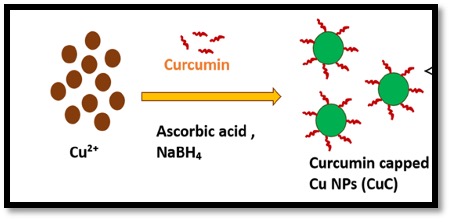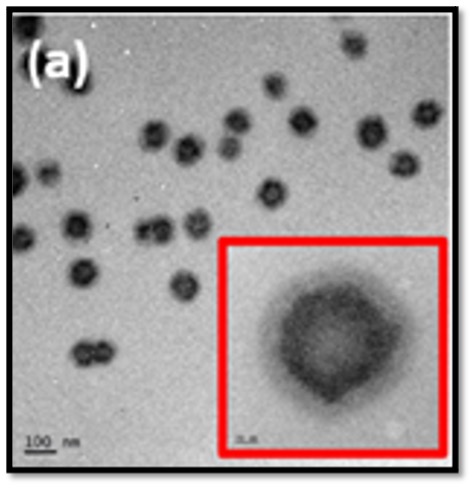| Apr 26, 2022 | |
Nanotechnology-enabled low-cost, point-of-care, self-test of sodium in the comfort of your home |
|
| (Nanowerk Spotlight) Researchers from the Central University of Kerala, India, have developed a point-of-care, portable, rapid, and cost-effective test for clinical diagnosis of sodium, which uses a paper printed colorimetric sensor that is based on Curcumin-functionalized copper nanoparticles. | |
| Sodium is a vitally important electrolyte present in all body fluids and it plays a crucial role in maintaining normal body function, including nerve and muscle function. It is also referred to as natrium or Na+. | |
| Electrolytes are minerals that carry a charge and exist in your body fluids. Sodium along with other electrolytes helps cells to function normally and it helps to regulate the amount of fluid (water and electrolyte) balance in the body. It stimulates muscle contraction and maintains a stable acid-base balance in blood and tissue cells. | |
| Low blood sodium – hyponatremia – is occurring commonly in older adults, especially those who are hospitalized or living in long-term care facilities. Signs and symptoms of hyponatremia can include altered personality, lethargy and confusion. Severe hyponatremia can cause seizures, coma and even death. | |
| Blood sodium measurement is used to detect the cause and help monitor treatment in persons with dehydration, oedema, or with a variety of symptoms. The blood sodium concentration is abnormal in many diseases, particularly, if the patient has symptoms of illness involving the brain, lungs, liver, heart, kidney, thyroid, or adrenal glands. | |
| The most serious symptoms of high blood sodium – hypernatremia – result from brain dysfunction. Severe hypernatremia can lead to confusion, muscle twitching, seizures, coma, and death. Similarly, regular diagnosis of sodium concentration in excreted urine can help to detect the cardiovascular diseases and hypertension. | |
| Point of Care test (POCTs) are portable, rapid, and cost-effective analysis and diagnosis in modern healthcare. They are a radical departure from the conventional clinical laboratory techniques to self or bedside diagnostic methods, which can be operated without experienced technicians. | |
| The largest benefit of POCTs are that they can be done rapidly and be performed by clinical personnel who are not trained in clinical laboratory procedures. Rapid test results can provide a physician and other clinical personnel with answers that can quickly help determine a course of action or treatment for a patient | |
| Urine sodium concentrations are typically tested in patients who have abnormal blood sodium concentrations, to help determine whether an imbalance is due to taking in, or losing, too much sodium. Urine sodium is also used to see if a person with high blood pressure is eating too much salt. This test is often used in persons with abnormal kidney tests to help the doctor determine the cause of kidney disease, which can help guide treatment. | |
| However, ions like potassium ion (K+), Mg2+ and Zn2+ do interfere with the Na+ in the conventional test, which poses a major hurdle in sodium detection. | |
| A variety of methods are used for the determination of sodium present in urine – such as ion-selective electrodes and ion chromatography – which are very accurate and free of errors. However, these are expensive methods, the testing process takes a long time of about 24 hours, and the quantity of sample required is relatively large. | |
| In contrast, paper-based dipsticks are more convenient to use, affordable, and provide quick results. | |
| In view of this, various nanoparticle-based approaches are also being developed for the detection of sodium ion concentration in the body fluid. However, interfering ions are posing a major obstacles in the case of ion sensing. In the case of sodium ion detection, particularly, Ions like K+, Mg2+ and Zn2+ cause major interference, which shows indiscernible nature in nanoparticle-based colorimetric sensing. | |
| Extensive research activities are in progress on novel sensing technologies like lateral flow strips and microfluidic pads for early diagnosis of diseases. Among the newly emerging sensing technologies, colorimetric sensing is of paramount importance because it is an easy, economical and reliable method that is amenable to the visual detection. | |
| The presence of metal ions, proteins, amino acids and specific biomarkers can be detected using colorimetric sensing. Also, paper-based strips can be used, which are inexpensive, and they are easy to use in devices for patients for diagnostics and emergency applications. | |
| The colorimetric sensing technique involves changes in color that make it possible to detect analytes in an expeditious manner with the naked eye and without the use of any complicated instrument. This provides a simple yet powerful detection mechanism that is well-suited to the development of low-cost and low-power sensors. | |
| Generally, the sensing mechanism is based on the molecular interaction – attractive or repulsive forces between molecules and between non-bonded atoms – between the specific analytes and the nanoparticle???s surface that is decorated with suitable surfactants. Nanoparticles, as label-free systems, exhibit efficient chemical or biological sensing properties. The availability of the finest colloidal metal nanostructures with meticulously engineered surfaces makes the detection endowed with high selectivity and sensitivity. | |
| Metal nanostructures – depending on their size and shape – possess noteworthy attributes, including catalytic, optical, electrical, and chemical properties; hence they are excellent candidates as sensors for optical, and catalytic and various other functional applications. They possess unique structural and optical properties, including quantum size effects, Surface plasmon resonance (SPR), along with large surface to volume ratio, which makes them ideally suited for broad areas of material applications. | |
| Recently, metal nanoparticles are being used for biomedical applications, including biosensing, immunotherapeutics, drug delivery, regenerative medicine, bioimaging, and wound healing. | |
| Among metal nanoparticles, copper nanoparticles (Cu NPs) have emerged as promising candidates for biomedical applications, especially biosensing, owing to the Surface plasmon resonance (SPR) spectra occurring in the visible range and fluorescence properties with favorable quantum yield. | |
| Nanoparticles are easily prone to surface oxidation, because copper oxides are more stable in the atmosphere. So, in general, synthesis methods using efficient surface modification agents are more appealing to prevent the oxidation of Cu NPs. Surfactants or ligands like citric acid, glutathione and cysteine, are normally used for protecting the surface of metal nanoparticles, especially Cu NPs. These surface modified Cu NPs hold great potential for the fabrication of colorimetric and fluorescence-based sensor strips. | |
| In the present study (Scientific Reports, "Development of a paper printed colorimetric sensor based on Cu-Curcumin nanoparticles for evolving point-of-care clinical diagnosis of sodium."), the research team has synthesized Curcumin functionalized Cu nanoparticles (CuC) and examined their application in sodium metal ion detection. | |
 |
|
| Schematic illustration of the formation of curcumin capped Cu NPs (CuC). (Image: Adapted from Scientific Reports, Springer Nature) | |
| Curcumin is the active component of turmeric with bright yellow color In the present investigation, the researchers have used curcumin to protect the Cu NPs from oxidation and agglomeration. They observed that the sensing system made up of CuC exhibits high levels of selectivity for sensing and quantifying Na+ ions. | |
| In this work, paper-based sodium sensor strips were fabricated, and it was found that visual detection of Na+ is possible in the physiological range using the same system. Using chemical reduction technique, the researchers synthesized nanoclusters of 3???9 nm-size consisting of highly stable, pure copper nanoparticles surface-functionalized with curcumin. | |
 |
|
| TEM image of curcumin capped Cu NPs (CuC). Inset figure shows the curcumin cage and inner core. (Image: Adapted from Scientific Reports, Springer Nature) | |
| Each nanocluster of particles is encapsulated with a curcumin layer, which is clearly visible in TEM images. The researchers found that these curcumin functionalized Cu NPs (CuC) are highly selective to the colorimetric detection of Na+. The ions like K+, Mg2+ and Zn2+ did not interfere with the Na+ in this sensing technique. | |
| In this work, low-cost paper-based sensor strips are fabricated and calibrated for the sensing of sodium in the physiological range and shade cards were developed as a calorimetric guide for estimation of Na+, which makes them ideal point of care diagnostic platform. | |
| The authors demonstrate that the proposed CuC paper strip can be used for detecting Na+ concentration within the whole physiological range in both blood serum and urine. | |
|
By Yashwant Mahajan, Associate Editor, Nanowerk
|
|
|
Become a Spotlight guest author! Join our large and growing group of guest contributors. Have you just published a scientific paper or have other exciting developments to share with the nanotechnology community? Here is how to publish on nanowerk.com. |
|
